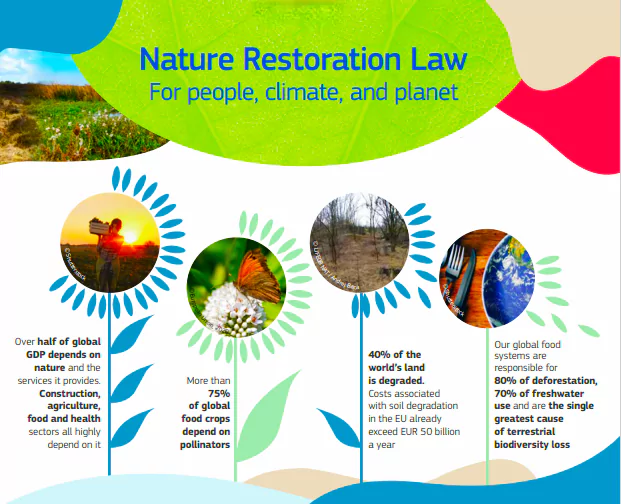The EU’s Nature Restoration Law (NRL) to restore nature was given the green light by the European parliament recently.
About EU’s Nature Restoration Law (NRL)

- Adopted: June 17, 2024, by the EU’s Environmental Council.
- Scope: Part of the EU’s Biodiversity Strategy 2030 and European Green Deal.
- Objective: The law aims to restore 20% of the EU’s land and sea areas by 2030, expanding to 90% by 2050.
- Restoration of 30% of degraded habitats by 2030, 60% by 2040, and 90% by 2050.
- Key actions:
- Restore 25,000 km of rivers.
- Plant 3 billion trees by 2030.
- Scope: It targets degraded ecosystems like forests, rivers, and wetlands, especially those in Natura 2000 (protected areas).
- Addresses biodiversity loss and improves the condition of degraded habitats (80% in Europe).
Enroll now for UPSC Online Course
Natura 2000
- It is a network of nature protection areas in the territory of the European Union.
- It is made up of Special Areas of Conservation and Special Protection Areas designated under the Habitats Directive and the Birds Directive, respectively.
- The network includes both terrestrial and Marine Protected Areas.
- Founded: 1992
|
- Biodiversity Goals: Aligned with the EU’s 2030 biodiversity strategy and the global Kunming-Montreal framework, which seeks to conserve 30% of land and sea by 2030.
- Flexibility for Member States: Countries choose specific areas and ecosystems for restoration, submit national restoration plans, and are required to monitor and report progress regularly.
Significance of Nature Restoration Law (NRL)
- Climate Mitigation: Healthy ecosystems are crucial for absorbing carbon emissions, reducing the impacts of extreme weather, and increasing climate resilience.
- Biodiversity Preservation: Restoring habitats will support endangered species and contribute to the survival of ecosystems crucial for pollinators, agriculture, and food security.
- Economic Gains: Nature restoration can generate significant economic returns by enhancing agricultural productivity, water security, and creating jobs, particularly in rural areas.
- The EU commission’s impact assessment suggests economic benefits of €1.86 trillion by 2050 from restoration actions compared to the €154 billion cost.
- Sustainable Development: Aligns with global goals like SDG 15 (Life on Land) by promoting sustainable land use and combating desertification.
- Climate Resilience: Restored ecosystems buffer against the adverse impacts of climate change, such as floods and droughts, improving environmental stability.
Challenges of Implementing Nature Restoration Law
- Agricultural Impact: Resistance from farmers concerned about reduced arable land and potential negative effects on food production.
- Political Pushback: Conservative and nationalist parties may resist restoration efforts due to perceived conflicts with economic growth or sovereignty over natural resource management.
- Economic Costs: High initial investments and implementation costs may deter immediate adoption despite long-term benefits.
- Coordination Across States: Ensuring compliance and coordination between states or regions, each with varying environmental priorities and governance structures, is challenging.
- Urbanization Pressure: In rapidly urbanising areas, balancing land restoration with development needs is difficult.
- Peatland Restoration: Resistance from farming communities due to targets for restoring drained peatlands, as it may reduce arable land.
Check Out UPSC NCERT Textbooks From PW Store
Need for Nature Restoration Law in India
- Deforestation
- Forests are being depleted at an alarming rate for commercial purposes, which can lead to climate change.
- According to the Environment Ministry, over 3 lakh hectares of forest land in India has been diverted for non-forestry use since 2008-09.
- Land degradation
- Agricultural land and forests are the most common types of land that are degraded in India. This can lead to food insecurity and climate change.
- 97.85 million hectares (29.7%) degraded (2018-19), up from 94.53 million hectares in 2003-05.
- Desertification affected 83.69 million hectares in 2018-19.
- High degradation in Gujarat, Karnataka, Maharashtra, and Rajasthan.
- Water pollution
- Most rivers, lakes, and surface water in India are polluted.
- The main sources of water pollution are untreated sewage, agricultural runoff, and unregulated small-scale industry.
- Based on analysis of water quality data, CPCB in year 2022, has identified 311 polluted river stretches on 279 rivers in 30 States/ UTs in the country based on indicator of organic pollution i.e. Biochemical Oxygen Demand (BOD) (3mg/L).
- Groundwater in India can be contaminated by trace metals like nickel, copper, chromium, lead, mercury, and cadmium.
- Groundwater depletion
- Groundwater storage in north India is rapidly declining due to natural and anthropogenic factors. This is a major challenge for food and water security.
- India extracts around 230 billion cubic meters of groundwater each year for agriculture.
- North India has experienced rapid groundwater depletion, losing 450 cubic kilometers between 2002 and 2021.
- The Central Groundwater Board (CGWB) reports that 17% of groundwater blocks are overexploited, with 5% at a critical stage and 14% at a semi-critical stage.
- Soil erosion
- Soil erosion is a serious threat to survival and well-being in India. It occurs in forest lands, agricultural lands, and other areas.
- The average annual soil loss in India is 21 tons per hectare.
- The National Bureau of Soil Survey and Land Use Planning estimates that around 30% of the soil in India is degraded.
- Of the eroded soil, 29% is lost to the sea, 10% is deposited in reservoirs, and 61% is shifted from one place to another.
- Biodiversity loss
- Factors that have contributed to the decline of India’s biodiversity include habitat loss, hunting, poaching, over-exploitation, and forest fires.
- India with 2.4% of total global land area is home for about 8% of global biological diversity.
- The IUCN lists at least 97 mammals, 94 bird species, and 482 plant species in India as threatened with extinction.
- Population growth
- According to the United Nations, the current population of India in 2024 is 1,44 billion, a 0.92% increase from 2023. It is more than four times since the 1951 census.
Challenges for Environmental Restoration in India
- Rapid Urbanisation: Increasing urban sprawl puts immense pressure on natural ecosystems, leading to deforestation, loss of wetlands, and shrinking green spaces.
- Agricultural Expansion: Intensive farming practices, monoculture, and land-use change for agriculture contribute to land degradation, soil erosion, and depletion of biodiversity.
- Industrial Pollution: Pollution from industries, including untreated waste disposal into rivers, lakes, and soil, severely hampers restoration efforts, especially in critical ecosystems like rivers and wetlands.
- Lack of Funding and Resources: Insufficient financial allocation and technical expertise hinder large-scale restoration projects, especially in rural and remote areas.
- Weak Policy Enforcement: Even though environmental laws exist, poor implementation and weak enforcement mechanisms prevent effective ecosystem restoration.
- Community Resistance: Local communities, particularly those dependent on natural resources for livelihood, may resist restoration efforts, fearing loss of access to land or disruption of economic activities.
- Climate Change Impacts: The increasing frequency of extreme weather events—droughts, floods, and rising temperatures—exacerbates degradation and complicates restoration efforts.
- Fragmented Governance: Environmental management responsibilities are split across different levels of government and agencies, leading to poor coordination and slow decision-making.
Way Forward for Environmental Restoration in India
- Legally Binding Restoration Targets: India should establish a Nature Restoration Law with legally binding targets, similar to the EU’s NRL, aiming to restore 20% of degraded ecosystems by 2030 and all by 2050.
- Integrated Land and Water Management: Adopting a holistic approach to managing land, forests, rivers, and wetlands will help restore ecosystems while enhancing agricultural productivity and water security.
- Community Participation: Involve local communities, especially those dependent on natural resources, in restoration efforts through employment opportunities, awareness campaigns, and participatory governance.
- Strengthening Policy Implementation: Ensure strict enforcement of environmental laws with stronger monitoring mechanisms and penalties for non-compliance, to safeguard restored areas.
- Public-Private Partnerships: Encourage collaboration between the government, private sector, and civil society organisations to mobilise funding, technical expertise, and innovation for large-scale restoration projects.
- Climate-Resilient Restoration: Incorporate climate resilience into restoration projects by using climate-adaptive species and restoration techniques to address the impacts of global warming.
Enroll now for UPSC Online Classes
Conclusion
A Nature Restoration Law would help restore ecosystems and boost socio-economic development while addressing climate change. Inspired by the EU, India’s legislation could set a global precedent in environmental governance.
![]() 25 Oct 2024
25 Oct 2024


